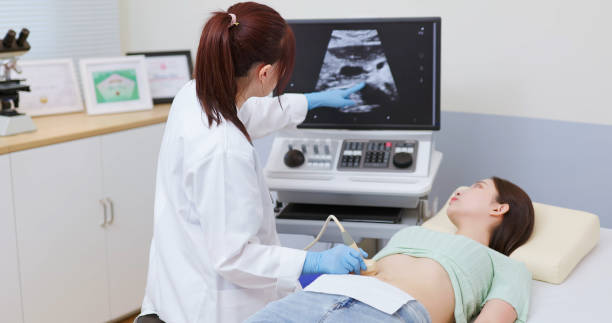Ovarian cancer is a formidable and often silent adversary in the realm of women’s health, representing a significant cause of morbidity and mortality. Originating in the ovaries, which are part of the female reproductive system, ovarian cancer often goes undetected until it has advanced to later stages, making early diagnosis challenging. This malignancy is particularly concerning due to its subtle and nonspecific symptoms that can easily be mistaken for less severe health issues.
Understanding ovarian cancer involves delving into its various types, risk factors, and the molecular mechanisms driving its progression. It encompasses a spectrum of tumors, with epithelial ovarian cancer being the most common and the most aggressive form. Risk factors such as age, genetic predispositions (like BRCA1 and BRCA2 mutations), and family history play crucial roles in the development of this disease.
Advancements in medical research have led to better diagnostic tools, more effective treatments, and a deeper understanding of the genetic and environmental factors involved. Despite these advancements, ovarian cancer remains a leading cause of gynecological cancer deaths, underscoring the need for continued research and awareness. This introduction aims to provide a comprehensive overview of ovarian cancer, shedding light on its impact, challenges in early detection, and the ongoing efforts to improve patient outcomes through innovative therapies and preventive strategies.
Table of Contents
Types of Ovarian Cancer

Ovarian cancer encompasses a diverse group of tumors that originate from different cells within the ovaries. Understanding the various types is crucial for accurate diagnosis, treatment planning, and prognosis. Here are the primary types of ovarian cancer:
- Epithelial Ovarian Cancer:
- Overview: The most common type, accounting for about 90% of all ovarian cancers.
- Subtypes:
- Serous Carcinoma: The most frequent subtype, including high-grade serous carcinoma (HGSC) and low-grade serous carcinoma (LGSC).
- Mucinous Carcinoma: Characterized by mucus-producing cancer cells.
- Endometrioid Carcinoma: Often associated with endometriosis and resembling the lining of the uterus.
- Clear Cell Carcinoma: A rarer and more aggressive form, often linked to endometriosis.
- Brenner Tumor: A rare subtype, usually benign but can be malignant.
- Germ Cell Ovarian Cancer:
- Overview: Arises from the cells that produce eggs (ova), accounting for about 1-2% of ovarian cancers.
- Subtypes:
- Dysgerminoma: The most common germ cell tumor, generally occurring in younger women.
- Endodermal Sinus Tumor (Yolk Sac Tumor): Highly malignant and typically seen in young women and children.
- Teratoma: Can be mature (benign) or immature (malignant), containing various types of tissue such as hair, muscle, and bone.
- Choriocarcinoma: Rare and highly malignant, often producing high levels of hCG (human chorionic gonadotropin).
- Stromal Cell Ovarian Cancer:
- Overview: Develops from the connective tissue cells that hold the ovary together and produce female hormones.
- Subtypes:
- Granulosa Cell Tumors: The most common stromal tumors, usually slow-growing and hormonally active.
- Sertoli-Leydig Cell Tumors: Rare tumors that can produce male hormones (androgens), leading to virilization.
- Thecoma and Fibroma: Generally benign tumors that can produce estrogen or be hormonally inactive.
- Small Cell Carcinoma of the Ovary (SCCO):
- Overview: A rare and highly aggressive form of ovarian cancer that primarily affects younger women.
- Characteristics: Often associated with hypercalcemia (high levels of calcium in the blood).
Rare Types
- Primary Peritoneal Carcinoma (PPC):
- Overview: Closely related to epithelial ovarian cancer but originates in the peritoneum, the lining of the abdominal cavity.
- Similarities: Presents and behaves similarly to ovarian cancer, treated with similar protocols.
- Ovarian Sarcoma:
- Overview: A rare type that arises from the connective tissue of the ovary.
- Characteristics: Often more aggressive and treated differently from other ovarian cancers.
Understanding the different types of ovarian cancer is essential for tailoring treatment and improving outcomes. Each type has distinct characteristics, prognoses, and treatment approaches. Accurate classification and diagnosis are vital for developing effective treatment plans and advancing research in ovarian cancer.
Symptoms of Ovarian Cancer

Ovarian cancer is often called a “silent killer” because its early symptoms can be subtle, nonspecific, and easily mistaken for other benign conditions. Recognizing the signs and symptoms of ovarian cancer is crucial for early detection and improving outcomes. Here are the primary symptoms associated with ovarian cancer:
- Abdominal and Pelvic Symptoms:
- Bloating: Persistent swelling or a feeling of fullness in the abdomen.
- Pelvic Pain: Discomfort or pain in the pelvic region, often described as a dull ache or pressure.
- Abdominal Pain: Unexplained and persistent pain in the abdomen.
- Gastrointestinal Symptoms:
- Urinary Symptoms:
- Frequent Urination: An increased need to urinate more often than usual.
- Urgent Urination: A sudden and strong urge to urinate.
- General Symptoms:
- Fatigue: Persistent and unexplained tiredness or weakness.
- Unexplained Weight Loss or Gain: Noticeable changes in weight without a clear reason.
- Reproductive Symptoms:
- Menstrual Irregularities: Changes in menstrual cycles, including heavier or irregular periods.
- Postmenopausal Bleeding: Any bleeding or spotting after menopause.
- Other Symptoms:
- Back Pain: Persistent pain in the lower back.
- Pain During Intercourse: Discomfort or pain during sexual activity.
Advanced Symptoms
In more advanced stages of ovarian cancer, additional symptoms may include:
- Ascites: Buildup of fluid in the abdomen, causing significant swelling and discomfort.
- Shortness of Breath: Difficulty breathing due to fluid accumulation around the lungs (pleural effusion).
- Leg Swelling: Swelling in the legs or feet due to lymphatic obstruction.
While the symptoms of ovarian cancer can be vague and easily overlooked, paying attention to your body and seeking medical advice when something feels wrong is essential. Early recognition and timely medical intervention can make a crucial difference in the management and prognosis of ovarian cancer.
Causes of Ovarian Cancer

The exact causes of ovarian cancer are not fully understood, but several factors are known to increase the risk of developing the disease. Understanding these risk factors can help in identifying individuals at higher risk and taking preventive measures. Here are some of the primary causes and risk factors associated with ovarian cancer:
- Genetic Factors:
- Inherited Gene Mutations: Mutations in specific genes, such as BRCA1 and BRCA2, significantly increase the risk of ovarian cancer. These mutations can be passed down through families.
- Family History: A family history of ovarian cancer, breast cancer, or colorectal cancer can indicate a higher risk due to shared genetic factors.
- Reproductive History:
- Age: The risk of ovarian cancer increases with age, particularly after menopause. Most cases are diagnosed in women over 50.
- Childbearing Status: Women who have never been pregnant have a higher risk of developing ovarian cancer compared to those who have had full-term pregnancies.
- Menstrual History: Early onset of menstruation (before age 12) or late menopause (after age 52) increases the risk due to prolonged exposure to estrogen.
- Hormonal Factors:
- Hormone Replacement Therapy (HRT): Long-term use of hormone replacement therapy, particularly estrogen alone without progesterone, has been linked to an increased risk of ovarian cancer.
- Fertility Treatment: Certain fertility treatments, particularly those that stimulate ovulation, may slightly increase the risk.
- Lifestyle Factors:
- Obesity: Being overweight or obese is associated with a higher risk of developing ovarian cancer.
- Diet: Diets high in fat and low in vegetables and fruits may increase the risk, although the evidence is not conclusive.
- Smoking: Smoking has been linked to a higher risk of mucinous ovarian cancer.
- Medical Conditions:
- Endometriosis: Women with endometriosis have an increased risk of developing certain types of ovarian cancer, such as endometrioid and clear cell carcinomas.
- Polycystic Ovary Syndrome (PCOS): While the link is not definitive, PCOS is associated with a higher risk of endometrial and ovarian cancers.
- Environmental Factors:
- Asbestos Exposure: Exposure to asbestos has been linked to an increased risk of ovarian cancer.
- Talcum Powder: The use of talcum powder in the genital area has been suggested as a potential risk factor, though the evidence is mixed and inconclusive.
Protective Factors
While certain factors increase the risk of ovarian cancer, some factors are believed to reduce the risk:
- Oral Contraceptives: Long-term use of birth control pills has been shown to reduce the risk of ovarian cancer.
- Pregnancy and Breastfeeding: Full-term pregnancies and breastfeeding are associated with a reduced risk.
- Tubal Ligation and Hysterectomy: Surgical procedures such as tubal ligation (having your tubes tied) or hysterectomy (removal of the uterus) may lower the risk.
The development of ovarian cancer is influenced by a complex interplay of genetic, hormonal, reproductive, and lifestyle factors. Awareness of these risk factors can help in early detection and prevention strategies. Women with a higher risk, especially those with a family history of ovarian cancer or known genetic mutations, should discuss regular screenings and preventive measures with their healthcare providers.
Diagnosis of Ovarian Cancer

Diagnosing ovarian cancer involves a combination of medical history assessment, physical examinations, imaging studies, laboratory tests, and sometimes surgical procedures. Early diagnosis is challenging but crucial for improving treatment outcomes. Here are the primary steps and methods used in the diagnosis of ovarian cancer:
- Medical History and Physical Examination:
- Symptom Review: Detailed discussion of symptoms, their duration, and severity.
- Family History: Assessment of family history of ovarian, breast, or colorectal cancers to identify genetic risks.
- Pelvic Examination: A thorough examination of the pelvis to detect abnormalities such as masses or fluid buildup.
- Imaging Studies:
- Transvaginal Ultrasound (TVUS): An ultrasound probe inserted into the vagina provides detailed images of the ovaries and surrounding tissues, helping to detect tumors or cysts.
- Abdominal and Pelvic Ultrasound: External ultrasound to visualize the ovaries and detect any abnormalities.
- CT Scan or MRI: Advanced imaging techniques that provide detailed cross-sectional images of the abdomen and pelvis to identify the size, shape, and spread of tumors.
- PET Scan: A special type of imaging that helps to identify cancerous cells in the body using a radioactive substance.
- Blood Tests:
- CA-125 Test: Measures the level of CA-125, a protein often elevated in women with ovarian cancer. It is not definitive but can be used alongside other tests.
- HE4 Test: Another blood test that measures the level of HE4 protein, which can be elevated in ovarian cancer.
- Other Biomarker Tests: Tests for other markers like CA 19-9, CEA, and AFP may be used to provide additional information.
- Biopsy and Surgical Procedures:
- Laparoscopy: A minimally invasive surgical procedure where a small camera (laparoscope) is inserted into the abdomen to examine the ovaries and take tissue samples (biopsies) for analysis.
- Laparotomy: A more extensive surgical procedure where an incision is made in the abdomen to remove larger tissue samples or tumors for biopsy.
- Needle Biopsy: A fine needle is used to extract a small sample of tissue from a suspected tumor, typically guided by imaging techniques.
- Genetic Testing:
- BRCA1 and BRCA2 Testing: Testing for mutations in these genes, which significantly increase the risk of ovarian and breast cancers.
- Other Genetic Tests: Tests for other genetic mutations, such as those in the Lynch syndrome genes, may also be conducted.
- Staging:
- FIGO Staging System: The International Federation of Gynecology and Obstetrics (FIGO) staging system is used to determine the extent and spread of ovarian cancer, ranging from stage I (localized) to stage IV (advanced spread).
Early detection of ovarian cancer significantly improves the chances of successful treatment and survival. Due to the often subtle and nonspecific nature of its early symptoms, a combination of thorough medical evaluation, advanced imaging, and laboratory tests is essential for accurate diagnosis. Women at high risk, especially those with a family history or genetic predisposition, should discuss regular screenings with their healthcare providers. Prompt and precise diagnosis is the first step toward effective management and improved outcomes for ovarian cancer patients.
Treatment of Ovarian Cancer

The treatment of ovarian cancer typically involves a combination of surgery, chemotherapy, targeted therapy, and sometimes radiation therapy. The specific treatment plan depends on the type and stage of the cancer, as well as the patient’s overall health and personal preferences. Here are the main treatment options for ovarian cancer:
- Surgery:
- Debulking Surgery: The primary goal is to remove as much of the tumor as possible. This often involves the removal of the ovaries, fallopian tubes, uterus, nearby lymph nodes, and any visible tumors in the abdomen.
- Hysterectomy: Removal of the uterus, which may be part of the debulking surgery.
- Bilateral Salpingo-Oophorectomy: Removal of both ovaries and fallopian tubes.
- Omentectomy: Removal of the omentum, a layer of fatty tissue in the abdomen where cancer often spreads.
- Lymphadenectomy: Removal of lymph nodes to check for the spread of cancer.
- Chemotherapy:
- Neoadjuvant Chemotherapy: Administered before surgery to shrink the tumor, making it easier to remove.
- Adjuvant Chemotherapy: Given after surgery to eliminate any remaining cancer cells and reduce the risk of recurrence.
- Intraperitoneal Chemotherapy: Chemotherapy drugs are delivered directly into the abdominal cavity to target cancer cells more effectively.
- Targeted Therapy:
- PARP Inhibitors: Drugs like olaparib, niraparib, and rucaparib target cancer cells with specific genetic mutations (e.g., BRCA1 and BRCA2) and prevent them from repairing DNA damage, leading to cell death.
- Bevacizumab (Avastin): An anti-angiogenic drug that inhibits the growth of blood vessels that supply tumors, starving the cancer cells.
- Radiation Therapy:
- External Beam Radiation: Uses high-energy beams to target and kill cancer cells. It is not commonly used for ovarian cancer but may be considered in specific cases.
- Brachytherapy: Internal radiation where radioactive materials are placed close to or inside the tumor.
- Hormone Therapy:
- Tamoxifen: Sometimes used to treat certain types of ovarian stromal tumors.
- Aromatase Inhibitors: Drugs like letrozole and anastrozole may be used to lower estrogen levels and slow the growth of hormone-sensitive tumors.
- Immunotherapy:
- Immune Checkpoint Inhibitors: Drugs that help the immune system recognize and attack cancer cells. They are currently being studied in clinical trials for ovarian cancer.
- Clinical Trials:
- Participation in clinical trials can provide access to new and experimental treatments that are not yet widely available. These trials can be a valuable option for patients, especially those with advanced or recurrent ovarian cancer.
Supportive and Palliative Care
In addition to the treatments aimed at eliminating cancer, supportive and palliative care play crucial roles in managing symptoms and improving quality of life:
- Pain Management: Use of medications, nerve blocks, or other interventions to control pain.
- Nutritional Support: Dietary counseling and supplements to maintain strength and body weight.
- Psychosocial Support: Counseling and support groups to address emotional and psychological needs.
- Symptom Management: Treatments to control symptoms like nausea, fatigue, and fluid buildup (ascites).
The treatment of ovarian cancer requires a multidisciplinary approach tailored to the individual patient’s needs. Advances in surgery, chemotherapy, targeted therapy, and supportive care have significantly improved outcomes for many women with ovarian cancer. Ongoing research and clinical trials continue to explore new and more effective treatments. Patients should work closely with their healthcare team to understand their treatment options and make informed decisions about their care.
Prevention of Ovarian Cancer

While there is no guaranteed way to prevent ovarian cancer, certain strategies and lifestyle choices can help reduce the risk. Understanding the risk factors and implementing preventive measures can be crucial, especially for individuals with a higher genetic predisposition. Here are some effective ways to lower the risk of ovarian cancer:
- Genetic Counseling and Testing:
- BRCA1 and BRCA2 Mutations: Women with a family history of ovarian or breast cancer should consider genetic counseling and testing for BRCA1 and BRCA2 mutations. Knowing your genetic status can guide preventive measures and early detection strategies.
- Preventive Surgery:
- Prophylactic Oophorectomy: For women with a high genetic risk (e.g., BRCA mutations), removing the ovaries and fallopian tubes can significantly reduce the risk of ovarian cancer.
- Hysterectomy: In some high-risk cases, removing the uterus along with the ovaries and fallopian tubes may be recommended.
- Oral Contraceptives:
- Birth Control Pills: Long-term use of oral contraceptives has been shown to reduce the risk of ovarian cancer. However, it’s important to discuss the potential benefits and risks with your healthcare provider.
- Pregnancy and Breastfeeding:
- Full-Term Pregnancies: Having one or more full-term pregnancies can lower the risk of ovarian cancer.
- Breastfeeding: Breastfeeding for a year or more may also reduce the risk.
- Healthy Lifestyle Choices:
- Diet: Consuming a diet rich in fruits, vegetables, and whole grains while limiting red and processed meats may help lower cancer risk.
- Exercise: Regular physical activity is associated with a reduced risk of many types of cancer, including ovarian cancer.
- Weight Management: Maintaining a healthy weight can help reduce the risk of ovarian cancer.
- Avoiding Known Risk Factors:
- Smoking: Avoiding smoking can reduce the risk of ovarian and other cancers.
- Talcum Powder: Some studies suggest a possible link between the use of talcum powder in the genital area and ovarian cancer. It may be prudent to avoid using talc-based products in this area.
- Regular Medical Checkups:
- Pelvic Examinations: Regular pelvic exams can help detect abnormalities early.
- Awareness of Symptoms: Being aware of and promptly reporting symptoms such as bloating, pelvic pain, and changes in bowel or bladder habits can lead to earlier diagnosis and treatment.
- Risk-Reducing Medications:
- Chemoprevention: For high-risk women, certain medications that reduce estrogen levels may be considered to lower the risk of ovarian cancer. These should be discussed with a healthcare provider.
- Education and Awareness:
- Stay Informed: Keeping up with the latest research and guidelines on ovarian cancer prevention and risk factors can help in making informed decisions about health.
While it is not possible to completely eliminate the risk of ovarian cancer, adopting preventive strategies can significantly reduce the likelihood of developing the disease. Women, particularly those with a high genetic risk, should discuss their options with healthcare providers to develop a personalized prevention plan. Regular medical checkups, a healthy lifestyle, and being aware of symptoms are key components in the proactive management of ovarian cancer risk.
Comorbid Conditions Associated with Ovarian Cancer
Comorbid conditions are other medical conditions that occur alongside ovarian cancer, potentially complicating diagnosis, treatment, and overall management. These conditions can impact the patient’s health, treatment decisions, and prognosis. Here are some common comorbid conditions associated with ovarian cancer:
- Cardiovascular Diseases:
- Hypertension (High Blood Pressure): Common in older patients and those undergoing certain cancer treatments.
- Heart Disease: Risk can be increased by certain chemotherapy agents and the stress of cancer treatment.
- Metabolic Disorders:
- Diabetes Mellitus: Cancer patients may have pre-existing diabetes or develop it due to treatment-related weight gain and changes in metabolism.
- Hyperlipidemia: High cholesterol levels can be exacerbated by sedentary lifestyle and cancer treatments.
- Respiratory Conditions:
- Chronic Obstructive Pulmonary Disease (COPD): Pre-existing lung conditions can complicate surgery and recovery.
- Asthma: Can be triggered or worsened by certain treatments and stress.
- Gastrointestinal Disorders:
- Irritable Bowel Syndrome (IBS): Symptoms like bloating and abdominal pain can overlap with ovarian cancer symptoms.
- Gastroesophageal Reflux Disease (GERD): Can be aggravated by certain cancer treatments and medications.
- Renal and Hepatic Conditions:
- Chronic Kidney Disease (CKD): Can complicate the administration and excretion of chemotherapy drugs.
- Liver Disease: Pre-existing liver conditions can affect drug metabolism and overall treatment tolerance.
- Endocrine Disorders:
- Hypothyroidism or Hyperthyroidism: Thyroid function can be affected by cancer treatments and stress.
- Adrenal Insufficiency: Can be a rare side effect of certain treatments or a pre-existing condition.
- Musculoskeletal Disorders:
- Osteoporosis: Risk can be increased by hormonal changes and cancer treatments.
- Arthritis: Joint pain and inflammation can be exacerbated by inactivity and certain medications.
- Neurological and Psychiatric Conditions:
- Depression and Anxiety: Common among cancer patients due to the emotional burden of the disease.
- Neuropathy: Nerve damage caused by chemotherapy can lead to peripheral neuropathy, causing pain, tingling, and numbness.
- Autoimmune Disorders:
- Rheumatoid Arthritis (RA): Chronic inflammation can complicate cancer treatment and management.
- Systemic Lupus Erythematosus (SLE): Autoimmune conditions can flare up with stress and cancer treatments.
- Infectious Diseases:
- Chronic Infections: Conditions like chronic hepatitis or HIV can impact immune function and complicate treatment.
- Recurrent Infections: Cancer treatments can weaken the immune system, making patients more susceptible to infections.
- Hematologic Conditions:
- Anemia: Common in cancer patients due to blood loss, nutritional deficiencies, and bone marrow suppression from chemotherapy.
- Coagulopathies: Blood clotting disorders can be exacerbated by cancer and its treatments.
Managing Comorbid Conditions
Managing comorbid conditions effectively is crucial for optimizing the overall health and treatment outcomes of ovarian cancer patients. Here are some strategies:
- Comprehensive Care: A multidisciplinary approach involving oncologists, cardiologists, endocrinologists, and other specialists to manage comorbid conditions alongside cancer treatment.
- Regular Monitoring: Frequent assessment of comorbid conditions to adjust treatment plans as necessary.
- Medication Management: Careful selection and dosing of medications to minimize interactions and side effects.
- Lifestyle Modifications: Encouraging healthy lifestyle choices, including diet, exercise, and smoking cessation, to improve overall health.
- Psychosocial Support: Providing mental health support through counseling, support groups, and stress management techniques.
Ovarian cancer patients often face the challenge of managing multiple comorbid conditions that can complicate their treatment and affect their quality of life. A holistic and coordinated approach to care, involving various healthcare professionals, is essential to address these complexities and improve patient outcomes. Recognizing and actively managing comorbid conditions can help ensure that ovarian cancer patients receive the most effective and comprehensive care possible.
Living with Ovarian Cancer

Living with ovarian cancer presents numerous physical, emotional, and practical challenges. Patients must navigate treatment regimens, manage symptoms, and maintain quality of life. Comprehensive support, including medical care, emotional support, and lifestyle adjustments, can significantly impact the journey. Here’s a guide to living with ovarian cancer:
- Medical Management:
- Regular Follow-ups: Consistent appointments with oncologists to monitor the disease, manage symptoms, and adjust treatments as necessary.
- Managing Side Effects: Addressing side effects of treatments such as chemotherapy and radiation, which may include nausea, fatigue, pain, and neuropathy.
- Medications: Taking prescribed medications to control symptoms and manage side effects effectively.
- Complementary Therapies: Considering complementary therapies like acupuncture, massage, and yoga to alleviate symptoms and improve well-being.
- Emotional and Psychological Support:
- Counseling and Therapy: Seeking professional help from counselors or psychologists to manage the emotional toll of cancer.
- Support Groups: Joining support groups to connect with others facing similar challenges, providing a sense of community and shared understanding.
- Mindfulness and Relaxation Techniques: Practicing mindfulness, meditation, and relaxation techniques to reduce stress and anxiety.
- Nutrition and Physical Activity:
- Balanced Diet: Eating a nutritious diet to maintain strength and energy. Focus on fruits, vegetables, lean proteins, and whole grains.
- Hydration: Staying well-hydrated to support overall health and manage treatment side effects.
- Exercise: Engaging in regular, moderate exercise to improve physical health, reduce fatigue, and enhance mood. Activities like walking, swimming, and gentle yoga can be beneficial.
- Managing Daily Life:
- Energy Conservation: Learning to balance activities with rest to manage fatigue effectively.
- Adaptive Equipment: Using tools and equipment to make daily tasks easier and safer.
- Home Modifications: Adjusting the living environment to accommodate changes in physical abilities.
- Work and Financial Concerns:
- Employment: Discussing with employers about flexible working arrangements or taking medical leave as needed.
- Financial Planning: Seeking advice on managing the financial impact of cancer treatment, including understanding insurance coverage, accessing financial aid, and managing expenses.
- Legal Rights: Knowing legal rights regarding employment and healthcare coverage.
- Family and Social Support:
- Open Communication: Maintaining open and honest communication with family and friends about needs and feelings.
- Caregiver Support: Ensuring that caregivers also have access to support and resources to manage their own well-being.
- Advance Care Planning:
- Living Will and Power of Attorney: Setting up a living will and appointing a power of attorney to make medical decisions if necessary.
- Discussing Wishes: Having conversations with family and healthcare providers about end-of-life care preferences.
Coping Strategies
- Stay Informed: Educate yourself about ovarian cancer, treatment options, and managing side effects to make informed decisions.
- Set Realistic Goals: Setting achievable goals helps maintain a sense of purpose and accomplishment.
- Celebrate Small Victories: Recognizing and celebrating small achievements can boost morale and motivation.
- Stay Connected: Maintain social connections to prevent feelings of isolation and loneliness.
Living with ovarian cancer requires a multifaceted approach that addresses the medical, emotional, and practical aspects of life. With the right support and resources, patients can navigate the challenges of their diagnosis and maintain a meaningful and fulfilling life. Regular medical care, emotional and social support, lifestyle adjustments, and proactive management of daily activities are key components to living well with ovarian cancer.
Conclusion
Living with ovarian cancer is a journey that encompasses numerous challenges and requires a comprehensive, multidisciplinary approach to care. Early detection, personalized treatment plans, and proactive management of symptoms and side effects are crucial for improving outcomes and quality of life. Equally important is the emotional and psychological support that can help patients and their families navigate the complexities of the disease.
Patients with ovarian cancer benefit greatly from regular medical follow-ups, effective symptom management, and a balanced approach to physical activity and nutrition. Emotional well-being is supported through counseling, support groups, and mindfulness practices, while practical aspects of daily life are managed through energy conservation strategies, adaptive tools, and financial planning.
The support system for ovarian cancer patients extends beyond healthcare providers to include family, friends, and community resources. Open communication, caregiver support, and advance care planning play vital roles in ensuring that patients’ needs and wishes are respected and met.
While the journey with ovarian cancer can be daunting, the combination of medical treatment, emotional support, and practical assistance enables patients to live meaningful and fulfilling lives. By staying informed, setting realistic goals, and celebrating small victories, patients can maintain a sense of control and hope.
Ultimately, living with ovarian cancer is about balancing the physical, emotional, and practical aspects of life, ensuring that patients receive the comprehensive care and support they need to thrive despite the challenges posed by the disease.
